| Thermalright SLK-900A
Heatsink From All Angles |
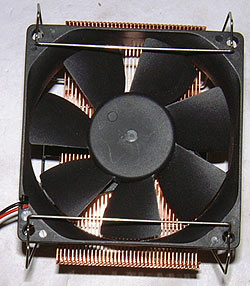 |
The Fan:
There are a
variety of fan sizes which can be used with the Thermalright SLK-900A
including; 92mm, 80mm, 75mm, 70mm, and 65mm widths. The wire clips
slide into small holes punched into the fins which hold the whole fan
retention clip assembly in place. Since the wire clips lock into the screw
holes there is no easy way of mounting a wire grill over the fan itself.
|
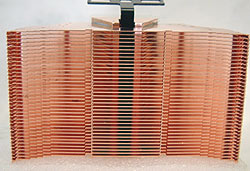 |
Heatsink Top:
There are approximately 36 sets of thin copper fins on the
SLK-900A. Each fin measures about 0.35mm thick and is a spaced 1mm apart.
The fins each have a small copper fold at the base 1mm wide which allows
them to be soldered to the sides of the triangular copper base. The copper
base is just 32mm wide, so add-ons like TEC's are not
feasible. |
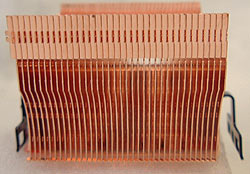 |
Side A:
Looking at the other side you can see the basic
fin structure that has gone into making this heatsink.
Notice how the copper base rises up to the center of
the heatsink 25mm, instead of just being a flat plate all the way across. The copper
fins have been soldered to the triangular copper base at the heart of the
SLK-900A, and to keep the fins in line at the outer edges there are interlocking
tabs. |
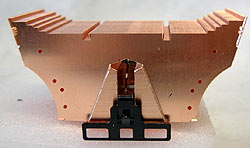 |
Side B:
There are four sets of holes for
various sizes, and widths of fans.
The steps at the top of the heatsink
correspond with different widths of fans. The triangular copper base
is 7mm thick at the bottom, and the two triangular sides rise up 25mm with a 7mm
space in the center for the three-prong clip. Note the small holes punched into the copper fins for the wire
clips. |
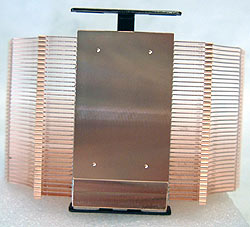 |
Heatsink
Base:
The base of the SLK-900A has been milled flat, and after checking with an engineers straight
edge we can see that the manufacturer has done a very good
job of keeping the surface true. The surface has a very slight milled finish,
but is otherwise pretty smooth. One end of the base is notched
to clear the socket cam arm. The fins stand out 13mm from the
base plate which allows exhaust air from the fan above to be
directed down towards the processor area.
|


